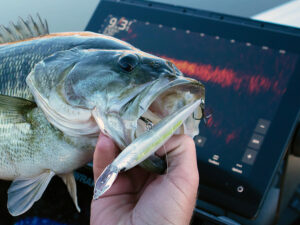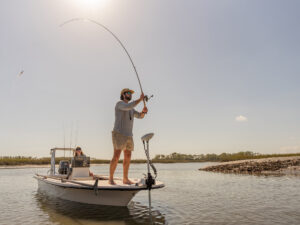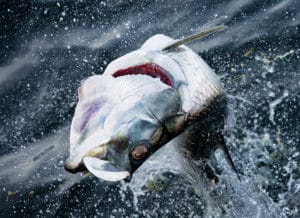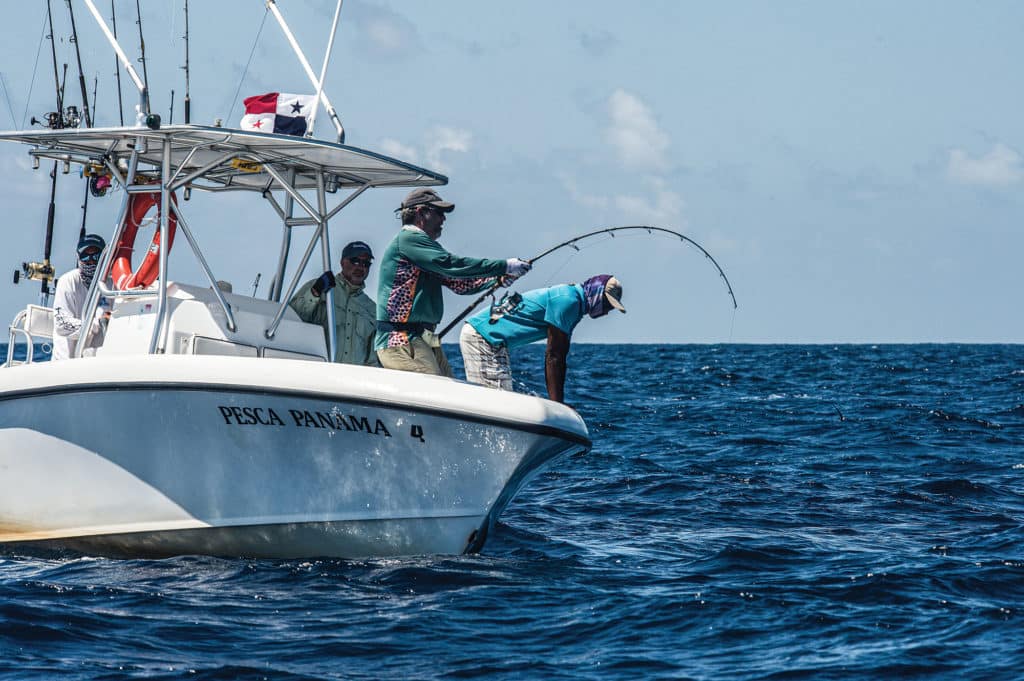
In the early and mid-1980s, I was fortunate to experience trolling for yellowfin and bluefin tuna off Block Island, Rhode Island, using plastic-skirted lures. When nearby tuna busted bait on top, the breathtaking excitement was second only to witnessing one crash a trolled lure. It never occurred to us that anglers would soon be casting big lures to these stunning fish and landing them using spinning outfits.
How it Started
Back in 2005, some anglers starting in the “tuna-pop” sport were using extra-heavy muskie or striped bass rods rigged with big-surf reels to cast top-waters at breaking fish. These outfits were cumbersome and tiring, especially with heavy mono line.
Randy Chin, CEO of Temple Reef rods and one of the pioneers in the heavy-spin-rod industry, says the evolution of heavy popping rods actually started in the late 1980s when Japanese anglers targeted giant trevally with long rods and big lures. These early plugging rods were up to 10 feet long and made of fiberglass/graphite composites. When superbraid gelspun polyethylene lines were refined and popularized, rods designed to cast lures became shorter and stronger because anglers could achieve greater distance with braid. That length, shorter by 2 feet or so, proved imperative for designing stronger and more efficient casting rods.
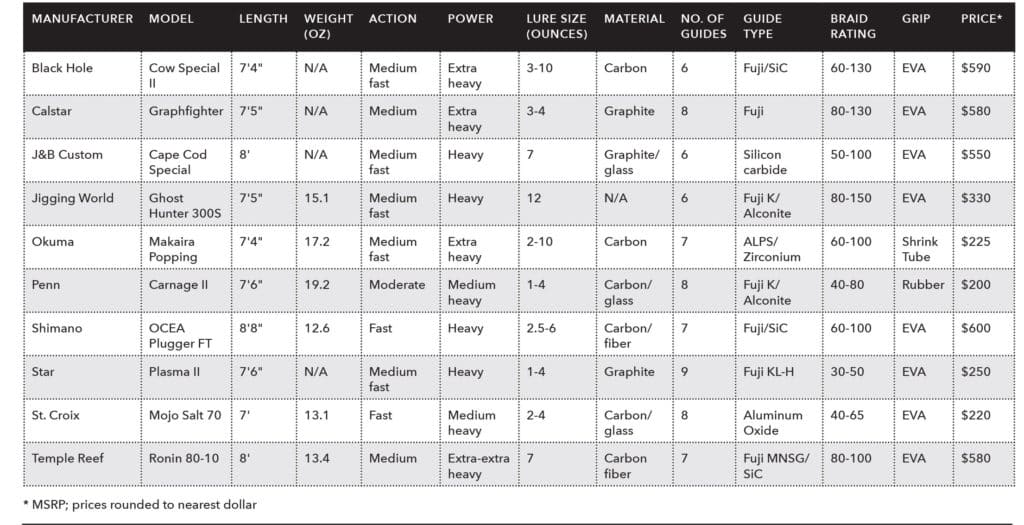
When spinning for tuna began in earnest in the Northeast, Chin says, skippers were skeptical of spinning rods and “coffee grinders,” as they called big spinning reels, until they witnessed him and others in 2006 subduing 50-pound bluefin in as little as five minutes. But as the individual size of that year class grew in subsequent seasons, so did the need for a rod specifically designed for targeting bluefin and yellowfin of more than 50 pounds because the long, heavy giant trevally rods weren’t efficient.
That’s when Chin developed his first purpose-made tuna casting rod, designed to handle 50- to 80-pound braid and to cast and work 4½-ounce lures.
High-Tech Materials: More Strength, Less Weight
Today, anglers routinely target not only large school tuna but predators such as giant trevally, amberjack, grouper and tarpon on tackle once thought suitable only for less-powerful species. The rods, in conjunction with ever-evolving, superduty spinning reels, not only must handle 100-pound-plus fish—but they also must sling 4- to 5-ounce jigs, poppers and stickbaits using heavy braid, yet be manageable enough for anglers to use for many hours.
A rod’s weight-to-strength ratio is the most significant recent advancement in blank material, says Blaine Anderson, field marketing manager with Shimano. Improvements in that ratio now make it possible to cast all day without tiring. A lure in the water, he notes, works far better than a lure in the cockpit during frequent rest periods.
Major advancements in materials used in rod construction include low-to-mid-modulus materials (modulus referring to stiffness in a rod) with higher tensile strengths. This increases the strain rate of the fibers, says Jason Brunner, director of Engineering and Manufacturing with St. Croix. He says better glass materials used in conjunction with carbon fiber offer the perfect combination of strength, power and action in St. Croix rods.
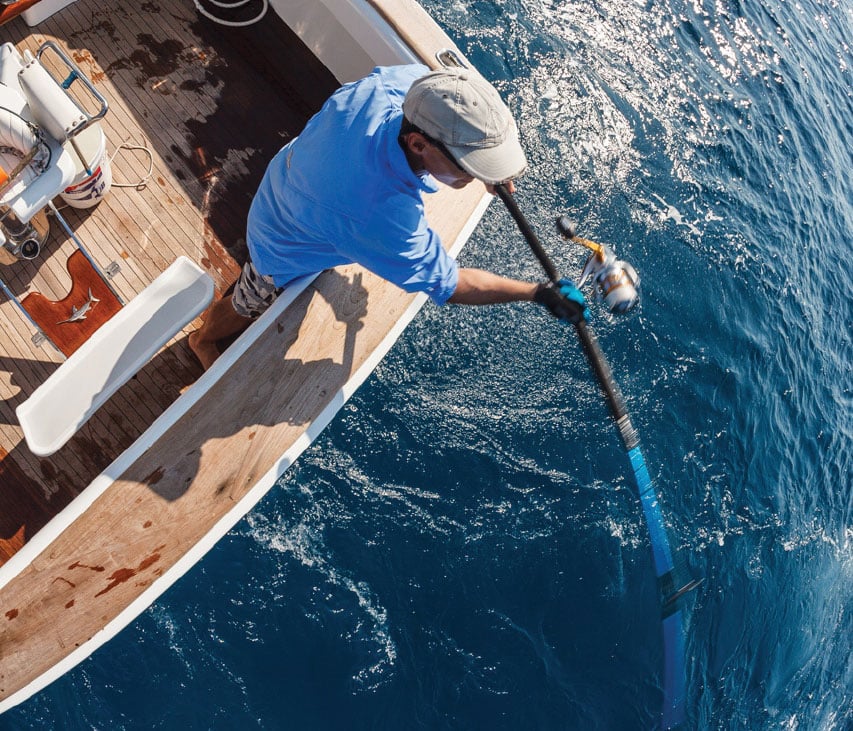
Modern materials also help in designing rods with technique-specific tapers, with the power needed for targeting big gamefish. The use of stronger, lighter blanks and composites—along with ultradurable components such as reel seats, guide frames and inserts, and butt sections, allow these rods to withstand the use of high-test braided lines, says Daniel Ramos, product-development assistant with Okuma.
Chin believes that enhancements to prepreg (a composite of fibers impregnated with epoxy resin), such as material-thickness variations, allow for finer tuning of rod action and strength, including the introduction of nanotechnology to prepreg. Fishing rods using silica nanoparticles fill spaces between carbon fibers to strengthen the rod without increasing the weight. These microscopic spheres of silica act as a homogenous, nonabrasive filler between the carbon fibers in a graphite rod blank. The result, he says: a much stronger, lighter product—important for well-designed popping rods.
Few popping rods are fitted with gimbal ends. Instead, many feature a rubber-knob butt to fit into belts that have cups without gimbal pins. The latter isn’t needed with spinning gear because “the gravity load from the spinning reel negates any torsional movement” of the sort that occurs with heavy conventional reels, Chin says. And not having to worry about seating a butt onto a gimbal pin allows for a more immediate, on-demand readiness to use a belt.
Guides
Improvements in guides is another significant change in the rod-building industry, in the opinion of Michael Bragg at Penn. Innovations in guide design, quality and trains (placement) provide anglers the ability to cast farther and more accurately, and high-tech guides have eliminated erosion or grooving by braided line during repeated intense battles.
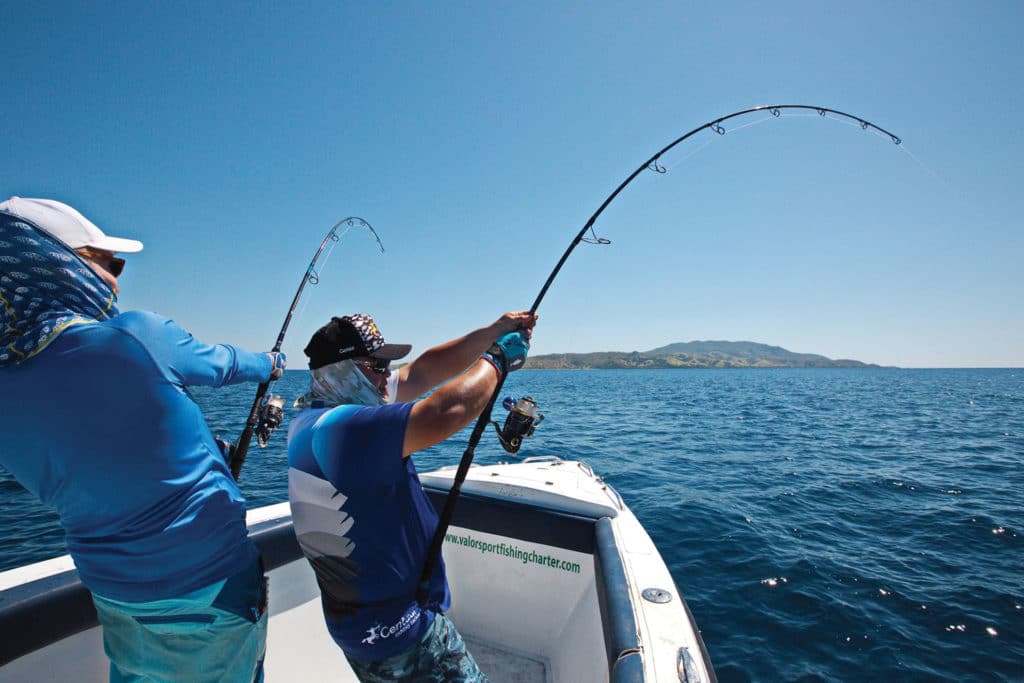
Braid-ready, one-piece guides eliminate insert pop-outs and provide long-lasting durability for anglers’ specific setups. The introduction of popular Fuji KW guides is a need-specific example of a strengthened frame that Fuji claims virtually eliminates inserts popping out, which renders the rod useless until guides are replaced.
“For a heavy casting rod,” Chin says, “the best blank material is 100 percent carbon fiber. Our preferred guide is Fuji’s MN guides with SiC [silicon carbide/ceramic] rings. Our preference for MN is mainly because they’re smaller to avoid flat spots from guides with longer legs. I believe SiC rings are necessary for heavy braid because ceramic has the best heat conductivity and better compression strength to keep the frame rigid.”
Length and Construction
There’s no single best all-purpose plugging rod, so how do you know what to look for? Anderson at Shimano says heavy-duty spinning rods should range from 7 to 8 feet or a bit more, be built with reinforcing construction methods and offer power ratings from medium to extra heavy. Shimano’s Ocean Plugger and Grappler Type C, for example, use a construction system consisting of three layers: vertical fibers, then an inner layer of spiral-wrapped carbon tape, and an outer layer of carbon tape spiral-wrapped in the opposite direction. This enhances torsional rigidity without adding extra weight. In some Shimano rods, additional power is gained by wrapping another outer layer of carbon tape to form an array of X shapes up the blank.
Chin says rod weight can limit the castability of a popping rod. He feels the ideal tuna-pop rod should weigh 14 ounces or so, and agrees with Anderson that a length of 8 feet or slightly more is ideal. Any shorter, he believes, will affect casting distance, and any longer will increase rod weight.
A moderate action is necessary for casting a variety of lure weights, and is ideal when fighting tuna because 80 percent of the battle is vertical. A moderate action places more pressure on the fish and less pressure on the standing angler due to the parabolic curve.
Grips
For rod grips, Chin adds, Temple Reef and most other manufacturers use EVA grips because they’re lightweight and durable. (EVA is an elastomeric polymer, which is “rubber-like” in softness and flexibility, has low-temperature toughness, stress-crack resistance, is waterproof and resistant to UV radiation.)
Read Next: Catch Massive Bluefin Tuna on Lures
One last important aspect of rod construction at Temple Reef is the length and position of the foregrip. Naturally, all anglers battling big fish want to grip their big-game rods as far up as possible to get the best leverage, which means at the top of the foregrip. But because of the finesse of these popping rods, placement of the hand far up on the rod can result in “high-sticking,” which often leads to a broken rod. Foregrips, Chin says, should terminate at the designed fulcrum point for maximum effectiveness without compromising the rod’s integrity.
“It’s like a plastic straw,” concludes Capt. Kyle Douton, manager with J&B Tackle in Niantic, Connecticut. “If you bend it too far, it suddenly creases. That’s how a rod snaps. The trick is to build a rod that will take extreme pressure and not ‘crease’ at a weak point. That’s what new technology is doing for us.”

